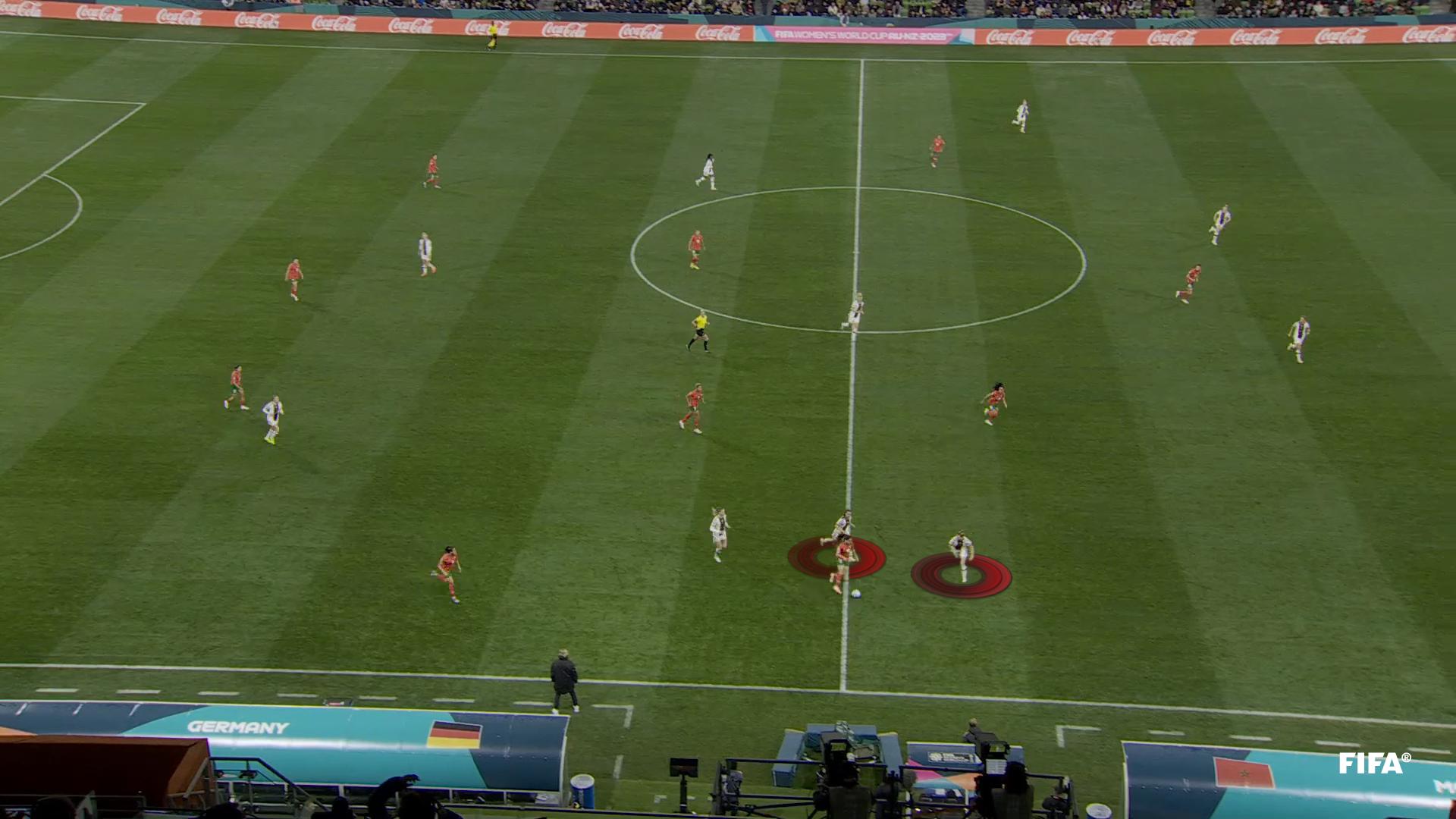On average, the ball is in play for approximately 60 minutes in a 90-minute game. In order to generate a clearer picture of what is happening during a team’s out-of-possession time, we normalise our data to the metric of “per 30 minutes out of possession.” Our data from the 2019 tournament has been calculated in the same way, therefore allowing comparisons that indicate genuine changes from that tournament to the 2023 competition. This article specifically compares defensive pressure (direct and indirect) in Australia and New Zealand to the previous tournament, the FIFA Women’s World Cup France 2019™.
Pressure applied
In total, pressure applied by teams in 2023 is down by 15% from 335 pressures per 30 minutes out of possession in 2019, to 285 in this tournament. This is driven by a decrease of 21% in indirect pressure applied. However, the application of direct pressure increased by 6% per 30 minutes out of possession in 2023. Interestingly, teams that applied more direct pressure won 68% of their games, indicating that the application of direct pressure was a characteristic for winning teams in this competition.
Chan Yuen Ting was part of FIFA’s Technical Study Group and she explains why this shift in defensive pressure occurred.
“Teams at this World Cup were extremely well organised and strategic about how and when they applied pressure. Defending is collective and teams do it together, so we saw a lot of defensive blocks where defending players waited and knew the triggers that would activate the press. Players do not go and defend on their own, they wait until the opportunity arises and then activate the press which at that point is often direct pressure. Its pre-planned, not ad hoc so the defensive behaviours of players are more tactical. This is partly why we saw less indirect pressure and slightly more direct pressure.”
Another contributing factor was the improved game management by teams in this competition. Teams decided when and why they were pressing and were more astute and considerate of the score line, time remaining in the game and what was needed from the game when considering their pressing strategies. Teams understood how and when they could conserve energy in the games, and this contributed to their decision-making around pressing.
As can be seen in the clips below, teams were often very strategic about how, when, where and why they activated their press. Pressing during the FIFA Women’s World Cup 2023 was extremely tactical, purposeful and co-ordinated.
Direct pressures by team and turnovers
When we analysed the application of direct pressure by team, it was notable that all three medal-winning teams (Spain, England and Sweden) were ranked in the top ten for direct pressures applied by team, per 30 minutes out-of-possession. However, semi-finalists Australia were among the lower ranked teams for direct pressures so preferred out-of-possession playing style is an important factor, including the defensive phases in which a team has decided to apply direct pressure.
It is also worth noting that teams who forced more turnovers of possession than their opponents won 76% of their games, averaging 20 more forced turnovers than the opposition. World champions, Spain, were the number one ranked team for forced turnovers in the final third, meaning they were often close to the opposition goal when they won the ball back.
Because of the collective nature of how teams are pressing, it can often lead to the player in possession of the ball becoming isolated. As can be seen in the clips below, once teams engaged in pressing, it often leads to multiple direct pressures and the elimination of passing options for the player being pressed. In clip 6, we see how Spain collectively isolate England’s Lucy Bronze, before forcing a turnover that leads to a goal being scored.
The forced turnover can also come from a misplaced pass from the in-possession player, due to the pressure they are under, and in clip 8, we see an example of this from the Netherlands’ game against South Africa.
High press and counter-press
Another interesting reference point that emerged from this tournament concerns the relationship between teams that spent more time in high press and counter-press phases, when out of possession in matches, and winning. While some teams preferred to press from low and mid-blocks, teams who spent a higher proportion of their out-of-possession time in a high press won 76% of their games, while teams who spent a higher proportion of their out-of-possession time in the counter-press phase, won 64% of their games.
In terms of actual time, on average in the tournament teams spent 54 seconds in high press and 252 seconds in counter-press, while winning teams spent on average 20 seconds more in high press and 49 seconds more in counter-press (per 30 minutes of out-of-possession time.)
However, these metrics did not directly correlate with progressing in the tournament when the average time spent in high press/counter-press phases were analysed. For example, Japan progressed to the quarter-finals despite being among the teams that spent the lowest percentage of time in high press/counter-press. Of the other teams that did progress to the knockout stages, winners Spain spent a higher proportion of time in the high press/counter-press phase.
When teams are attacking, especially in the final third, their ability to counter-press effectively depends on how close their nearest player is to the ball when it is lost, and how close other players are in order to support the press.
According to Chan, teams demonstrated a really good awareness of when it was viable to high press and counter-press, and this was a key factor in the success rates.
“Again, teams were more strategic about how and when they pressed high and counter-pressed, but when they did activate the press, it was often aggressive, disciplined and co-ordinated, especially when they had numbers around the ball and near the point of the transition. Teams know if they can press/counter-press or if they need to drop off into a block.”
SUMMARY
The 15% decline in overall defensive pressure applied during FIFA Women’s World Cup 2023 is symptomatic of a larger decrease (-21%) in indirect pressure applied and a small increase (+6%) in the volume of direct pressure applied throughout the tournament, with the correlation between direct pressure and forced turnovers being evident.
While all three medal-winning teams were ranked in the top ten for direct pressures applied, it must be noted that tactically teams had different approaches to how and where they applied pressure when out of possession. It is also noted that teams that spent a higher proportion of their out-of-possession time in high press and counter-press won more games, although this is not directly correlated with progressing in the tournament.
Champions Spain ranked third highest for the percentage of their out-of-possession time spent high pressing and counter-pressing and were the number one team in the competition for forced turnovers in the final third.
Overall, teams were defensively more organised and strategically cued to press off specific triggers. There was real game awareness and collective behaviour evident when teams were defending.


















